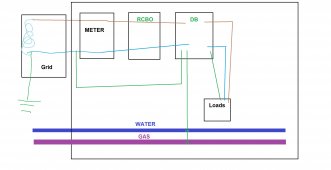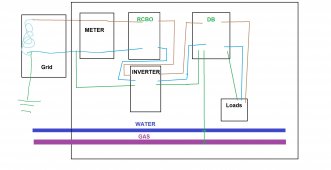Hi all,
New to the forum after a bit of lurking. I'm totally lost with grounding & earthing strategies and I wonder if anyone can help? I've read a LOT of posts on here but can't quite find this stuff so sorry if this is a bit "page 1"!
In simple terms my question is: What do you do about water and gas pipes? What do you want their potential to be, and how do you do it?
To elaborate:
Ignoring the solar install, my house appears to be on TNC-S from the DNO, where PE is split off before the meter and goes past a couple of RCBOs and then ties to the earth block in a couple of DBs for the house. The earth block in one of the DBs is then tethered to the incoming gas and water pipes.
I'm trying to install a Voltacon 8kW off-grid inverter with grid backup which *I think* does a N-E bond on the output when running off-grid but breaks the bond and passes the earth terminal through when running on utility. My initial thought was that I would need an external relay to switch to a local earth rod when running on battery? (Or just, have a floating system and hope RCDs stop us being deaded) BUT... here's where my understanding runs out:
(1) Again, ignoring solar, if the water and gas is connected to PE, does this not create problems where the pipes go back to earth (as in, planet Earth)? I thought you shouldn't add a local earthing rod to the PE (or N) of a TNC-S because of import/export/ground loop/other possible issues? Maybe I misunderstood.
(2) ignoring (1) if you use local earth for off-grid but use the TNC-S PE for on-grid operation, do you switch which one is connected to your water? And if so, how?
Thanks!
New to the forum after a bit of lurking. I'm totally lost with grounding & earthing strategies and I wonder if anyone can help? I've read a LOT of posts on here but can't quite find this stuff so sorry if this is a bit "page 1"!
In simple terms my question is: What do you do about water and gas pipes? What do you want their potential to be, and how do you do it?
To elaborate:
Ignoring the solar install, my house appears to be on TNC-S from the DNO, where PE is split off before the meter and goes past a couple of RCBOs and then ties to the earth block in a couple of DBs for the house. The earth block in one of the DBs is then tethered to the incoming gas and water pipes.
I'm trying to install a Voltacon 8kW off-grid inverter with grid backup which *I think* does a N-E bond on the output when running off-grid but breaks the bond and passes the earth terminal through when running on utility. My initial thought was that I would need an external relay to switch to a local earth rod when running on battery? (Or just, have a floating system and hope RCDs stop us being deaded) BUT... here's where my understanding runs out:
(1) Again, ignoring solar, if the water and gas is connected to PE, does this not create problems where the pipes go back to earth (as in, planet Earth)? I thought you shouldn't add a local earthing rod to the PE (or N) of a TNC-S because of import/export/ground loop/other possible issues? Maybe I misunderstood.
(2) ignoring (1) if you use local earth for off-grid but use the TNC-S PE for on-grid operation, do you switch which one is connected to your water? And if so, how?
Thanks!




